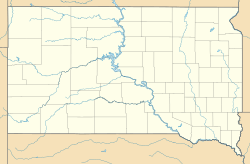Mystic, South Dakota facts for kids
Quick facts for kids
Mystic
|
|||||||||||||||||||
|---|---|---|---|---|---|---|---|---|---|---|---|---|---|---|---|---|---|---|---|

Gold dredge at Mystic, South Dakota, c. 1910
|
|||||||||||||||||||
| Country | United States | ||||||||||||||||||
| State | South Dakota | ||||||||||||||||||
| County | Pennington | ||||||||||||||||||
| Founded | 1876 | ||||||||||||||||||
| Elevation | 4,872 ft (1,485 m) | ||||||||||||||||||
| Population | |||||||||||||||||||
| • Total | 0 | ||||||||||||||||||
|
|||||||||||||||||||
Mystic is a fascinating ghost town located in Pennington County, South Dakota. It started as a gold mining camp way back in 1876. Back then, it was called Sitting Bull. Over time, railroads came to the area, connecting Mystic to other towns. However, its population slowly began to shrink in the early 1900s. Today, very few or no people live there permanently. The old townsite was even added to the National Register of Historic Places in 1986. It is now known as the Mystic Townsite Historic District.
Contents
Where is Mystic Located?
Mystic is nestled in the beautiful Black Hills of Pennington County, South Dakota. It sits right on Castle Creek. The town is about 20 miles (32 km) west of Rapid City. It's also about 12 miles (19 km) north of Hill City. You can find it where Mystic Road (County Road 231) meets George Frink Road.
A special path called the George S. Mickelson Trail has a starting point in Mystic. This trail is great for hiking and biking. Today, you can still see a few old sheds and summer cabins in Mystic. The most important building left is the McCahan Memorial Chapel. It was built in 1930 but closed in 1966.
Mystic's Story: A Look Back
How Mystic Began
The first white settlers arrived in this area in 1876. They set up a gold mining camp along Castle Creek. They named their camp Sitting Bull, after the famous Lakota chief. These early settlers looked for gold by panning in the creek. Others dug mineshafts in the nearby hills.
Even though some miners moved to Deadwood, the camp stayed busy. By 1879, about 100 people lived in Sitting Bull. In 1889, the settlement changed its name to Mystic. No one knows for sure why the name changed. Some people think it was because the local Native Americans believed the area was full of mystery. Others believe it was named after a town called Mystic, Connecticut.
In the same year, the Chicago, Burlington and Quincy Railroad built a railway to Mystic. This connected the town to Deadwood. Later, in 1906, another railroad arrived. This was the Rapid City, Black Hills and Western Railroad, also known as the Crouch Line. Mystic became the end of the line for trains coming from Rapid City. Mystic even got its own post office in 1895.
Mystic's Time of Growth
Mystic's good location for gold mining led to some interesting experiments. In June 1911, a company spent $100,000 to build the first gold dredge in the Black Hills. This machine was also the first electric gold dredge. It was located about 1.5 miles (2.4 km) upstream from Mystic. This dredge could process a lot of material each month. However, it cost much more money than it made. Within a year, the dredge was moved to Oregon.
In 1904, another company tried an experimental plant. This plant, called the Mystic Reduction Mill, cost over $1 million to build. It used a process called electrochlorination. By 1913, this operation also failed. In 1919, its foundation was used for a new sawmill. This sawmill was run by George Frink.
As local mining slowed down, the Frink Sawmill became the main employer in town. At different times, Mystic also had a Presbyterian church, a blacksmith shop, a school, and a grocery store. During the Great Depression, Mystic was home to a Civilian Conservation Corps (CCC) camp. This was the highest CCC camp in the Black Hills. The CCC workers planted many trees and fought forest fires. By November 1937, they had planted over 1.5 million trees.
Because two railroad lines met in Mystic, the town also attracted many tourists. In 1927, President Calvin Coolidge visited Mystic. He was touring the Black Hills and Mount Rushmore at the time. The Rapid City Daily Journal reported on his visit. The President and his wife visited the summer home of former Nebraska Governor Samuel Roy McKelvie. They arrived in Mystic on the Crouch Line. Then, George Frink drove them part of the way in his lumber wagon.
Why Mystic Became a Ghost Town
Mystic had already started to decline in the early 1900s. The town was very close to Castle Creek. This meant it suffered from many floods. These floods constantly damaged the railways, buildings, and other structures. For example, five railroad bridges were washed out in a flood in 1907. However, they were later replaced.
Several fires also threatened the community. This included multiple wildfires. The sawmill itself was destroyed by fire in 1936 but was rebuilt. Just three years later, a huge fire swept through the Black Hills. It destroyed several homes around Mystic. George Frink, who was the fire warden, called it "the worst I've ever seen." Also, the town was running out of easily accessible coal and timber.
After World War II, the town was abandoned even faster. The Crouch Line railroad was completely taken apart in 1947. The sawmill closed in 1952. The post office closed two years later. Its services were moved to the nearby Rochford post office. The Burlington rail line closed in November 1983. Today, part of this old rail line is now the George S. Mickelson Trail. Today, no permanent houses are occupied in Mystic.
On August 1, 1986, 43 acres (17 hectares) of the original townsite were added to the National Register of Historic Places.




